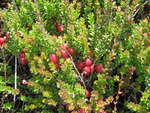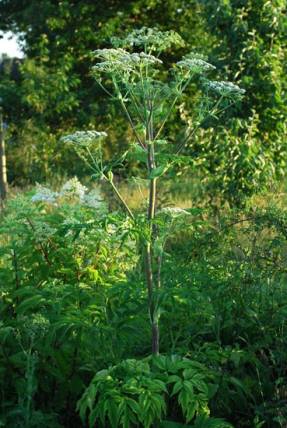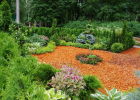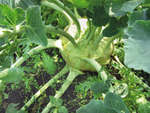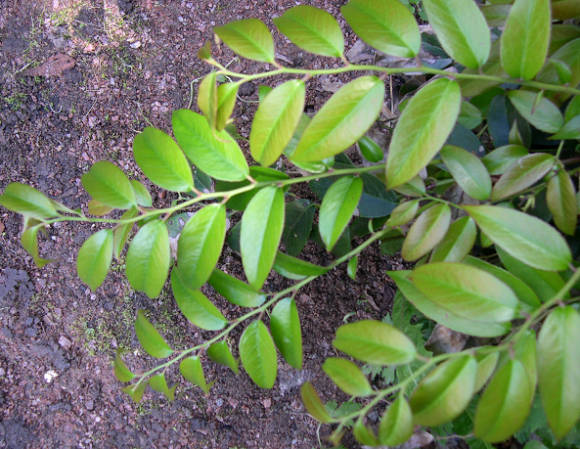In nature, there are about 500 species of barberry, the main representative of the barberry family (Berberidaceae). These are ornamental shrubs with elegant leaves, thorny shoots, spectacular during the period of lush flowering and abundant fruiting. Their dense root system is able to strengthen steep slopes, and the bark and roots are used for medicinal purposes. In a wide culture, only resistant species are most often found, distinguished by a large number of elegant varieties.
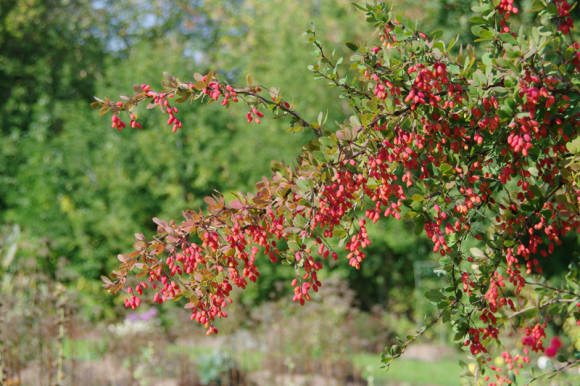
Common barberry (Berberis vulgaris) grows naturally in the forest-steppe zone of Russia, as well as in the Crimea and the Caucasus, among shrubs, on forest edges and on the slopes of ravines. Thorny shrub about 2.5 m high with yellowish-brown shoots, arched from the base of the bush. The spines are tripartite, up to 2 cm long. The leaves are dark green, grayish-green below, ovoid with a finely serrated edge, sit in small bunches on shortened shoots. In May-June, drooping brushes with shiny yellow honey flowers bloom on the bush, emitting a pleasant aroma. In autumn, the leaves turn yellow, and the brushes of bright red juicy fruits hang on the bush for a long time. Fruits up to 1.2 cm long, sourish, pleasantly refreshing taste is quite edible.
Common barberry is unpretentious in culture, has good winter hardiness, resistance to drought and dustiness of the air. It is not very demanding on soil conditions, although it prefers light and calcareous soils. The shrub tolerates slight shading, but abundant fruiting is possible in an open, sunny area. Easily recovers when pruned and gives large gains. Propagated by cuttings, dividing the bush and seeds. Used to create impenetrable hedges, group and specimen plantings. Its main drawback is susceptibility to fungal diseases: rust and powdery mildew, which are more often manifested in damp cold summers.
The red-leaved form is very popular with the common barberry. ‘Atropurpurea’ (Atropurpurea). The height of the bush is up to 2 m, the leaves are dark purple, the flowers are orange-yellow, the fruits are dark red. During seed propagation, part of the seedlings of this form retains varietal characteristics. The variegated form is much less common. 'Albovariegata ' (Albovariyegata) - a short bush (less than 1 m), dark green leaves with white strokes and stains. Do ‘Aureomarginata'(Aureomarginate) dark green leaves with a golden border and spots. These forms require sunny areas, since in low light, the intensity of the purple and variegated color of the leaves decreases. The form 'Serrata’ (Serrata) - with deep toothed leaves, 'Sulcata’(Sulkata) - with strongly ribbed shoots,’Alba’(Alba) - with white fruits,’Lutea’(Lutea) - with yellow fruits. ‘Macrocarpa’(Macrocarpa) has larger fruits,’Asperma’(Asperm) fruit without seeds.

Amur barberry (Berberis amurensis) grows in Primorye, Japan and China on rocky soil along the banks of mountain rivers, among shrubs and on the edges of forests. In its appearance, there is much in common with the common barberry. Tall, spreading bush up to 3.5 m tall. Young shoots are yellowish-gray, with tripartite spines about 2 cm long. Leaves are shiny and rather large, up to 5-8 cm long, obovate, with small denticles along the edge. In spring the leaves are bright green, in autumn they are yellow or red. The bushes bloom in late May and are covered with long racemose inflorescences (up to 10 cm long) with 10-25 yellow fragrant flowers. Shiny red fruits (up to 1 cm in diameter) are edible, sour taste, long weigh on the bush.
Amur barberry is unpretentious and winter-hardy, withstands drought and extreme heat. Not picky about the soil, grows well in a lit place. Propagated by seeds, cuttings, root suckers and layering. The most resistant to powdery mildew, less to rust and fusarium. Suitable for tall hedges, single and group plantings. The garden form is known in culture ‘Japonica’ (Japonica) with wide leaves, rounded at the top, and short racemose inflorescences with 6-12 yellow flowers and a domestic variety Orpheus, characterized by a low bush (about 1 m), compact crown, light green leaves, lack of flowering.
 |  |
Canadian barberry (Berberis canadensis) native to the eastern part of North America, where it is found along river valleys, steep banks, on high hills and rocks. Tall, spreading shrub up to 2.5 m tall with brown and dark purple shoots, also similar to the common barberry. Thorns are tripartite, up to 1.2 cm long. Leaves are oblong-oval, 2-5 cm long. Blossoms with yellow racemose inflorescences from late May to early June. Fruits are bright red, elongated-elliptical, up to 9 mm long. Bears fruit annually and is always abundant.

Canadian barberry also has good winter hardiness and undemanding soil. Photophilous and drought-resistant. The growth is large, it quickly recovers after pruning. Propagated by summer cuttings and seeds. Suitable for landscaping, but little divorced in Russia. In America, since 1730, decorative forms have been cultivated, possibly of hybrid origin - ‘Declinata’(Declinata) with yellowish-purple shoots and crimson-red fruits; ‘Oxyphylla'(Oxyphyllum) with pointed finely serrated leaves; ‘Rehderiana'(Rederian) with thin red-brown shoots, oval leaves 2-3 cm long, rounded bright red fruits.
Barberry Thunberg (Berberisthunbergii) comes from Japan and China, where it grows on mountain slopes. A small shrub up to 1 m high, with dense and spreading shoots, up to 1.5 m in diameter. Shoots at a young age are yellowish, later brown and purple-brown, densely covered with thin spines (1 cm long). The leaves are small (1-3 cm long) obovate, bright green, bright red or purple in autumn. It blooms annually, from late May to early June. Reddish-yellow flowers are collected in inflorescences (2-4). Coral red fruits can hang from the bush all winter. The fruits are unsuitable for food because of the bitter taste, as they are saturated with alkaloids and tannins, but birds readily feed on them.
Barberry Thunberg is resistant to drought, undemanding to the soil, unlike ordinary barberry, it is almost not affected by rust and powdery mildew. In a harsh winter, non-lignified shoots located above the snow level can freeze over. Easily tolerates a haircut, grows back quickly. Propagated by cuttings, dividing the bush and seeds. The Thunberg barberry has more than 50 interesting varieties that differ in foliage color, shape, size and winter hardiness.
- 'Aurea'(Aurea) has a rounded crown about 0.8 m high and yellowish-green shoots. In summer, the color of the leaves is yellow or lemon yellow, but in shaded areas it is light green. In autumn, the leaves are yellowish-orange. Flowers up to 1 cm in diameter, yellow inside, reddish outside, collected in clusters of 2-5 pieces. The fruits are bright red, shiny. It freezes slightly, recovers well, but the gains are small. Shelter is required for the first 2-3 years. A somewhat similar little-known variety 'Maria’(Maria) - with bright yellow leaves and a narrow dark red edging, in strong sun their color almost does not fade.
- 'Bonanza Gold' (Bonanza Gold), synonym ‘Bogozam ’ (Vogosam) - miniature variety with golden foliage. The crown is dense, pillow-shaped, a bush 30-50 cm high and 70 cm in diameter. The color of the leaves is lemon-golden, fading in strong sun. Flowering and fruiting are annual, the fruits are bright red. It hibernates only under snow; above the snow level it can freeze over.
- ‘Atropurpurea'(Atropurpurea) - a common variety, a bush 1.5 m high. The leaves are purple-red all season, and in autumn they are bright carmine. The flowers are yellow, with reddish streaks on the outside. The fruits are red. With seed propagation, varietal characteristics are not preserved. The variety looks like it ‘Carmen ’ (Carmen) with drooping branches and glossy red-brown leaves.
 |  |
- ‘AtropurpureaNana’ (Atropurpurea Nana) is a popular low-growing Dutch variety with a flat-round crown 0.4-0.6 m high, about 1 m wide.Leaves are dark purple, scarlet-red in autumn. Flowers up to 1 cm in diameter, yellow inside, red outside, collected in clusters of 2-5 pieces. The fruits are shiny, bright red. They look like him 'CrimsonPygmy’ (Crimson Pigmy) - American cultivar with a cushion crown, 'KleinerFavorit' (Kleiner Favorite) - German undersized variety, ‘Minima’(Minima) - Polish cultivar 40 cm high with rich dark purple color of leaves and American cultivar 'LittleFavorite' (Little Favorite).
- 'Bagatelle' (Bagatelle) - Dutch variety with a rich dark color of leaves, obtained from varieties ‘Atropurpurea Nana ' and 'Kobold '. The crown is densely branched and flat-spherical, the height of the bush is 0.4 m. The leaves are small, ovoid, brown-red, in the bright sun they become almost black-brown, in autumn they are bright red. In winter it freezes over, needs annual shelter, shoots grow poorly.
- ‘RedChief’ (Red Chief) - with narrow dark red leaves. The bush is large, height and diameter over 2.5 m, the crown is widely spreading. Mature shoots are red-brown. The color of young shoots and leaves is bright purple, at the base of the shoot is purple-brown, almost black. Leaves are lanceolate and obovate, about 3 cm long. The flowers are yellow, the fruits are pink and red. The variety is thermophilic, annual shoots freeze slightly.
- 'GoldenRing' (Golden Ring) - an original variety with a rounded crown, 1.5 m high. Leaves are ovoid, dark purple in color with even light green edging, in autumn red Flowers are collected in inflorescences of 2-5 pieces. Shiny red-coral fruits hang on the bush for a long time. Needs winter shelter. A similar variety 'Coronita ' (Coronita) - with smaller pointed leaves of the same color.
- ‘Admiration ' (Edmiration) also with a thin green border on a dark brown leaf.
 |  |
- ‘Dart'sRedLady’ (Darts Red Lady) - a variety with a red-leaved spherical crown. The height of the bush is 0.8 m. Young, shiny leaves of bright scarlet color, and the mature leaves at the base of the bush are red-brown. In autumn, the leaves are yellow. The variety is very freezing, must be covered, and in the spring, organic feeding is required. Similar variety 'Dart's Purple' (Darts Pöpl) with brownish-red leaves, bush up to 1 m high.In the red-leaved variety ‘RedKing’ (Red King) compact crown, height 0.8 m.
- ‘HelmontPillar’ (Helmont Pillar) is a red-leaved variety with a columnar crown, about 1.3 m high.Leaves are rounded, young are concentrated on the periphery of the bush, pink-red in color, and adults are red, in the lower tier closer to the base of the bush, the leaves are yellowish-green with a rich violet finish. Similar varieties ‘RedPillar’ (Red Pillar) with dark reddish purple leaves and ‘Red Rocket ' (Red Rocket) with red-brown leaves.
- ‘RoseGlow’ (Rose Glow) - a variety with a mosaic leaf color, up to 1.5-1.7 m high with an ovoid crown and straight prickly shoots. Young leaves are bright purple, with marbled bronze-red and pink-gray stains, mature leaves are dark pink and red-purple, with grayish splashes and spots. The degree of color depends on the illumination of the bush. Yellow flowers look spectacular against the background of foliage. She needs shelter, growth of 10-15 cm per year. Similar varieties'Ida'(Ida) and 'Rosetta' (Rosetta) with pink streaks and spots on burgundy leaves.
- 'Kelleriis' (Kelleris) - variegated variety with a wide spreading crown, up to 1.5 m high. The leaves are similar in shape and pattern to ‘RoseGlow’, only differ in green color. In autumn, the leaves are pink and red, with light patterns. The variety needs good care and winter shelter.
- 'Harlequin’ (Harlequin) - variegated, similar to ‘Pink Queen '. Shrub with an oval crown 1.3 m high and red, non-lignified shoots. The leaves are red with pink, gray and white streaks and specks. Compared to variety 'Rose Glow' there are more spots, and the leaf is lighter. Winter shelter is required, increments of 10-15 cm per year.
- 'Kornik' (Kornik) is a variegated variety with greenish-white leaves, on which there are numerous cream stains and spots. The bush is up to 1.5 m high. Young shoots are red-brown in color, prone to winter frosting, shelter is required.
 |  |
- Erecta’ (Erekta) - a graceful variety with small light green leaves, similar to a garden form ‘Minor’. The crown is narrow oval, up to 1 m high. In a young bush, the branches are directed upward, and with age, they are more deflected. Abundant flowering, light yellow flowers. In autumn, the leaves are purple, numerous red fruits ripen.
- ‘Kobold’ (Kobold) - a dwarf variety with small shiny green leaves, the height of the bush is about 0.5 m. Shoots are red-brown. The leaves are ovoid, dark green, orange-yellow and bright red in autumn.
Read also article about Thunberg barberry varieties Many-sided barberry.
Ottawa barberry (Berberis x ottawiensis) was obtained by hybridization between the Thunberg barberry and the red-leaved form of the common barberry ‘Atropurpurea’. The bush is up to 2 m high. The dark purple color of the ovoid leaves persists throughout the summer. In the fall, the leaves turn red. Flowers are yellow with a reddish tinge, collected in clusters of 8-10 pieces, bloom at the end of May. The fruits are dark red in color. The shrub is unpretentious and winter-hardy, gives large growths. Reacts well to pruning, tolerates drought, is almost not affected by diseases. Preferably a sunny place with light calcareous soil, mulching and application of organic fertilizers. Propagated by cuttings and seeds.
In culture, unpretentious and winter-hardy varieties are known. ‘Superba’ (Superba) - a variety with a rich and stable dark red color of foliage, the height of the bush is up to 2-3 m.The leaves are red or orange in autumn. The flowers are yellow-red, in a racemose inflorescence, up to 5 cm in length. The bright red fruits ripen in late September - early October. A similar variety 'Purpurea'(Purpurea) with brighter red shoots and scarlet leaves. ‘Auricoma’ (Aurikoma) is a red-leaved variety, up to 2.5 m high with rounded bright red leaves, orange in autumn.‘'Silver Miles’ (Silver Miles) - a variety with a silver pattern on dark leaves, up to 3 m high, yellowish flowers, red fruits.
 |  |
Korean barberry (Berberiskoreana) comes from the Korean Peninsula, grows on mountain slopes and in rocky gorges. Shrub more than 2 m in height. Leaves are obovate, larger, almost leathery, purple-red in autumn. The spines are strong, thickened and foliate widened. Bright yellow flowers with a strong odor, 15-20 pieces are collected in a brush. Fruits are scarlet-red, spherical in shape, about 1 cm in diameter. An unpretentious and winter-hardy shrub, only in severe winters the tips of the shoots freeze slightly. Suffers from high humidity during long winter thaws, susceptible to rust. Grows back quickly after pruning, tolerates heat and drought. Propagated by cuttings and seeds.
 |  |
Barberry whole-edged (Berberisintegerrima) native to Central and Central Asia, grows on slopes in mountain gorges at an altitude of 2500 m above sea level. Shrub about 2.5 m high with brownish-red branches. The spines are small, up to 1.5 cm long. Grayish-green oblong leaves with a solid edge. In inflorescences up to 20 yellow flowers are collected, fruits are oblong, reddish-black with a bluish bloom, up to 1 cm long. An ornamental and drought-resistant shrub, undemanding to the soil, likes limestone stony areas, grows poorly on acidic soil. Adult plants are winter-hardy; in young plants, non-lignified shoots freeze over in a harsh winter. Tolerates pruning, annual gains of medium length. Propagated by cuttings and seeds.
Ball-bearing barberry (Berberis sphaerocarp), synonym - multi-legged barberry (B. heteropoda), comes from the mountainous regions of Central Asia. Shrub up to 2.5 m high with sprawling shoots with grayish-green leaves, finely serrated along the edge. Fragrant flowers are collected in inflorescences of 5-10 pieces. Globular dark blue fruits with a bluish bloom. They are distinguished by the highest content of ascorbic acid and are used in food by the population of Kyrgyzstan, Uzbekistan and Tajikistan. Fruits are added to compotes, dried for pilaf, barbecue and shurpa.
Ball-bearing barberry - unpretentious shrub, tolerates heat and drought, loves gravelly lime soil.Adult plants overwinter well, at a young age they need shelter. If they suffer, then not from frost, but from excessive moisture in a cold rainy summer, after which they are exposed to diseases (rust). Their planting site in the garden should be protected from through winds, and the soil should be free from stagnant moisture. Easily tolerates pruning, good growth. Propagated by cuttings and seeds.
 |  |
Monet barberry (Berberisnummularia) native to Central and Central Asia, where it lives on dry steppe slopes. Branched shrub, up to 1.5-2 m tall, with large thorns (up to 3 cm) on reddish branches. Leaves are hard, oblong-elliptical, up to 4 cm long, whole-edged, bluish-green. Flowers are collected in large bright yellow clusters. Oval bright red fruits up to 1 cm in diameter. At a young age freezes over, recovers slowly. It is drought-resistant, dries up and gets wet with excessive moisture, susceptible to rust, light calcareous soil with good drainage is needed.
About agricultural technology - in the article Barberry: growing and reproduction
All about barberries - in the section Barberry

